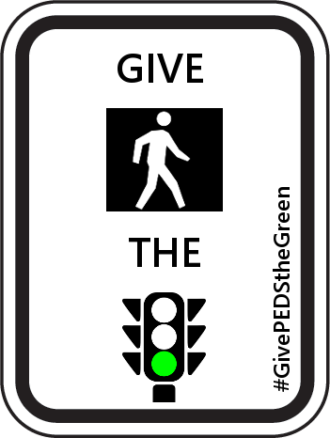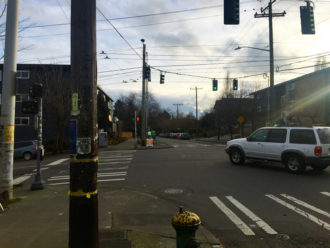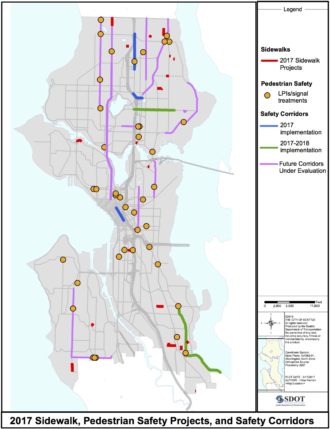
A new petition under the hashtag #GivePedsTheGreen is calling on SDOT to make an essentially invisible and low-budget change to traffic signals that could have a big impact on walkability, safety and accessibility in all corners of Seattle. It wouldn’t require any new infrastructure at all, and people driving would likely not even notice the change.
The idea is to program traffic signals in urban villages, the urban center and other areas with many people on foot so the walk signal is never skipped. Instead, just make the program behave as though someone pushed the button every cycle. It’s a pretty simple idea that could pack a big safety benefit.
The campaign was started by Troy Heerwagen, who has written for years at his blog Walking in Seattle. He wrote a post for the Urbanist Thursday explaining the idea and urging people to support the petition. He also says to always push the button when walking so SDOT has proper counts of how many people are trying to cross the street and can adjust signals accordingly.
I can’t possibly support this idea enough. So many safe streets projects require tough trade-offs or big capital budgets, but this one doesn’t. It’s a simple tweak, but it would improve comfort, efficiency, safety and accessibility for people walking around town.
Case study: 18th and Union

Sitting outside Tougo Coffee last summer, I saw a man with a vision-impairment and a white cane walk past my table on the sidewalk while I typed away writing this blog.
I focused on work for a few more minutes before sitting up and taking a sip of my coffee. That’s when I saw the man standing at the northeast corner of 18th and Union a half-block away feeling around a wooden telephone pole for a button to push so he could trigger the walk signal and cross the somewhat busy Union St. Had he been trying to get across the street the entire time I was working?
As a sighted person, I was able to identify the problem: The push button wasn’t on the telephone pole. He figured this out and felt around for a different pole, this one a large metal pole that supports the bus trolley wires. But this pole didn’t have a button either. When he turned back to try the wooden pole again, I got up and went to help. Before I could get there, though, someone driving pulled over, got out of his car and helped guide the man to the bus stop on the opposite corner.
That’s when I realized that the whole time he was searching for the button (it was on a third smaller pole closer to the intersection), the traffic signal had been going through its regular cycles for people driving but kept skipping the walk signal, which “chirps” to tell people with vision impairments which direction has the walk.
This intersection is one of the many, many intersections in the city where the walk signal will only be shown if someone pushes a button commonly (and perfectly) called a “beg button.” By skipping the walk signal, traffic engineers are able to add a few seconds to green lights, thus maximizing vehicle throughput.
But the cost of those extra seconds falls on people walking, who are inconvenienced at best and put at increased health risk at worst.
The man with the vision impairment I saw is a particularly egregious case showing how these buttons can cause some community members serious problems just because they can’t see which of the nearby poles has a button. But as I sat back down with my coffee fuming at how insensitively this cold and distant traffic signal program had just treated this man, I began to notice that sighted and able-bodied people were also being put in unfair and potentially dangerous situations.
Over and over, people arrived at the corner and either didn’t notice the button or didn’t push it early enough to get the walk. Once they realized that the light was green and they were getting skipped, they had two choices: Wait another minute or so for the cycle to come back around (which makes walking take longer than it should, decreasing the appeal) or make a run for the other side, hoping to get to there before traffic on Union got the green.
Predictably, most people who were physically able ran for it. Because of course they did. It’s “their turn,” or at least it should be.
We all know this feeling because it happens all the time all over the city. But it doesn’t need to be this way. It forces people to make a quick, tough decision between two unappealing options. And if they try to cross too late, the results could be tragic.
It more dangerous to cross without a walk signal because the blinking “don’t walk” signal gives people much more warning than a yellow light. It’s also illegal, which could result in tickets and unnecessary traffic stops. People can also potentially be held liable if they are injured or killed because they were crossing against the walk signal.
How many times have you seen a news story about someone hurt or killed walking across the street against the signal? It’s pretty hard to measure how many of those cases were people running for it after getting skipped (reports rarely go into such detail), but certainly some of them were.
With so many negatives piling up, I decided to hang around and time the signal to see how much extra green light time Union was getting in exchange for inconveniencing and endangering people walking. When 18th Ave received a green light without a walk signal, Union St traffic had a red light for 23 seconds. When the walk signal was triggered, Union had a red light for 26 seconds.
Three seconds. That’s all. If SDOT came out and changed the programming of this signal so the walk appeared every cycle, nobody driving would even notice the change. But people walking would never be skipped again.
This is just one intersection, and it’s not even a particularly notable example. But the same frustrating problem is playing out all over the city all day long every day, and SDOT can change it.
It wouldn’t even require extensive retiming work, which can be complicated and expensive. These signals already have walk times programmed, SDOT just needs to treat every cycle as though someone had pushed the button.
To be clear, the petition is not calling for the city to get rid of the buttons, which can serve important accessibility functions apart from triggering lights (like broadcasting audio alerts to help people with vision impairments).
And as with every rule, there are exceptions. There are some signals that only serve crosswalks and only turn red when someone pushes the button (for example, on Fremont Ave near B.F. Day Elementary). Those may be fine the way they are. A button that triggers the walk more quickly may also be a fine use. There may even be some intersections with very low numbers of people walking where someone could make the case that the “beg” requirement is not egregious (I’m not totally convinced of this, but areas with lots of people walking are definitely a higher priority).

This petition’s proposal also pairs well with the Mayor’s recently-announced plans to make more significant walk signal improvements at a bunch of intersections across the city. Called “leading pedestrian intervals” in the traffic engineering world, the retimed signals would give people walking a couple seconds of head start before the green light. This allows people to get fully established in the crosswalk before people try to make turns, improving their visibility and preventing dangerous situations where people try to squeeze through ahead of people crossing. We will have more on that in a future post, so stay tuned.
Here are three ways Heerwagen says you can help with the #GivePedsTheGreen campaign:
- Sign this petition to SDOT Director Scott Kubly asking for change.
- Tell everyone why the beg button should be banned under the hashtag #GivePedsTheGreen.
- Push the button. Always. As long as the push button is still used as a measurement of pedestrian activity, be sure to push it to make sure that SDOT counts people on foot when programming traffic signals.








Comments
14 responses to “#GivePedsTheGreen petitions SDOT to program traffic lights so they stop skipping walk signals”
Great topic for discussion. One person signing the Change.org petition wanted to go farther and give traffic signalling priority to pedestrians–their reason is that people travelling in climate controlled vehicles shouldn’t be prioritized above a family walking (or bicycling) in the rain.
As a courtesy to those crossing the street after you, you can push the button at the far side of the intersection – after you’ve finished crossing.
The city needs to adopt All Cross with major penalties. How many more deaths and injuries must Seattle families suffer before this simple solution is adopted?
[…] Graphic: Troy Heerwagen via Seattle Bike Blog […]
Here in Kent we have beg buttons that inexplicably make you wait more than one full cycle. Here is the current situation, when crossing 84th Ave S (East Valley Hwy) at S 212th St.
1. Press beg button to cross north/south while east/west bound traffic has green.
2. North/south cars get green but walk signal is still DON’T WALK. Pedestrians skipped.
3. East/west cars get green.
4. North/south cars get green and now walk signal changes to WALK. I can finally cross.
We also have some walk signals that actually change to WALK a fraction of a second AFTER the cars get the green, making it even more likely to get right hooked in the crosswalk. Welcome to Kent.
Okay, now let’s go all the way–have walk signals while there are red lights for vehicles at all four entry points to the intersection and GET RID OF THE FREE RIGHT TURN ON RED LIGHTS.
Yes please! I can’t tell you how many times I’ve just barely missed the walk signal at Toy and 1st Ave N. Usually I cross anyway, but yield to cars for safety. I swear I j-walk (and/or see someone else do it) 25% of the time–maybe more.
[…] Peds The Green: Seattle Bike Blog echoed Troy Heerwagen’s op-ed in The Urbanist calling on SDOT to automatically give pedestrians the […]
What an absolutely idiotic idea. Why do something that further increases driver frustration? As somebody who both drives and bikes, I think Seattle should be moving towards smart lights at all its junctions that only change for both pedestrians and autos when there is actually somebody there. I would much rather a campaign to reprogram crossing lights so that they change more quickly. In the same vein we need properly synchronized lights throughout the city so that lights change predictably and drivers are not incentivized to speed between lights in the hope of catching the next unsynchronized when it is green.
Drivers need to be forced to grow some patience. What is reasonable in the idea that drivers need to continue to be socially spoiled in this way? I am 62 years old, have been an active cyclist for nearly five decades and have seen the deterioration in driver behavior. It may be useful to stop thinking of motor vehicle operators as human beings and rather think of them as an uncontrolled apex predator with no natural enemies. I would like to see much more heavy-handed police behavior regarding the driving behavior of wealthy, white, employed, property owning people–crank up the opression until the average Audi-driving tech executive is treated as badly as an African-American driver in the jurisdiction of the country’s most racist police department. Give ’em a quota of developers and financial and tech fat cats to beat up publicly as an attempt to get them to obey speed limits, for instance. Drivers are treated entirely too well in this country–remember, the US Constitution contains the word “automobile” exactly zero times!
As someone who is Shomer Shabbos, these beg buttons create an additional hardship: Since I don’t travel by vehicle or operate any electronics on the Sabbath, I sometimes find myself stuck waiting at a high speed road until the traffic clears up a bit before darting across to safety.
Is it too much to ask that I have ONE car-free day a week?
This is a great idea. I was going to ask for a bike sensor on 35th Ave NE to help with the left turn to my daughter’s pre-school. When I’m on my bike with her in the child seat, we miss two or more walk cycles waddling up on to the curb, pressing the beg button, turning around a loaded bike and then I think even waiting an extra cycle before we get the walk sign. I’ve tried using the left turn lane, but it’s a steep uphill, so I’m only moving 6mph crossing several lanes of 35 mph traffic that way. It’s all the more important to have the walk sign and all the more of a hassle on a rainy morning.
Simply having a walk cycle with every light would be a lot safer in general, and that intersection’s getting new sidewalks. There’s no reason that we should assume everyone’s driving to the corner store.
Why slow down the cycle by waiting for peds if there aren’t any there? Seems like overkill.
Better idea: if a ped arrives while cars have green in your direction and presses the button, IMMEDIATELY give them a walk light and extend the vehicle green cycle accordingly.
Result: cars are happy, people are happy.
Arguing to delay everyone for nonexistent peds seems odd.
Tom, what you describe at 18th and Union is really two different issues: accessible pedestrian signals (signals that are audible so they can be detected by visually impaired) and incorporating a ped interval into every signal cycle. As an example, DC has the latter, but not every ped signal is accessible.
I completely agree with the notion of eliminating ped buttons in urban villages or where a higher number of peds can be expected. Along with this, shortening overall signal cycles is a proven countermeasure for improving signal compliance by peds (peds aren’t forced to wait long) and in most cases does not adversely impact traffic.
I continue to be baffled by some of SDOT’s decisions around signal timing, particularly given its focus on Vision Zero. A case in point is the signal at Jefferson and 23rd (Garfield High School). This is a location with many, many young people and transit riders crossing the street. They are forced to wait over 1 minute once the button is pushed. This was a high collision location prior to 23rd being reconstructed and I suspect it will continue to be given these long wait times. I often see kids and others trying to catch their bus darting across the street against the signal.